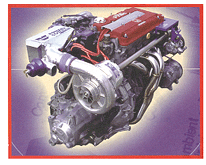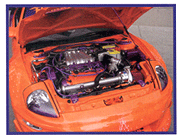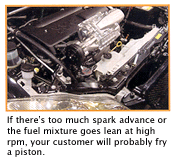4-cylinder engines are short on displacement, so to maximize their performance potential they have to be wound up and geared down. High rpm power is achieved with lots of valve opening and valve timing, but the trade-off is a loss of low-end torque and throttle response. Thats one reason why six-speed gearboxes are becoming common on sport compact cars. In my opinion, however, six gears are too many. Youre constantly sawing the gearshift lever back and forth with every speed change. Personally, I prefer fewer gears and more torque.
 In this article, were going to look at the intake side of the equation. Induction system upgrades can also give small engines a big increase in power and probably yield more bang for the buck than internal engine modifications. The kind of upgrades were talking about are bolt-on supercharger and turbocharger kits, along with intake manifolds, oversized throttle bodies, cold air intakes and nitrous oxide systems.
In this article, were going to look at the intake side of the equation. Induction system upgrades can also give small engines a big increase in power and probably yield more bang for the buck than internal engine modifications. The kind of upgrades were talking about are bolt-on supercharger and turbocharger kits, along with intake manifolds, oversized throttle bodies, cold air intakes and nitrous oxide systems.
Heavy Breathing
A naturally aspirated engine can suck in only so much air with every intake stroke of its pistons. As rpm increases, the volume of air ingested by the engine goes up, but breathing efficiency starts to drop off due to restrictions in the intake plumbing, heads and valves. The amount of power produced by the engine ultimately depends on how much air it takes in and how efficiently it breathes. As stated earlier, four-cylinder engines dont have a lot of displacement. A couple of liters arent a lot to work with. One way to make a little engine breathe big is to give it a bigger set of lungs with a blower. Forcing air into the engine under boost pressure increases air flow and breathing efficiency.
 It doesnt take much boost to make a big difference in horsepower and torque. Six or seven pounds of boost pressure generated by a supercharger will typically boost an engines power output 40 to 50 percent or more! Want more power? Just turn up the boost pressure.
It doesnt take much boost to make a big difference in horsepower and torque. Six or seven pounds of boost pressure generated by a supercharger will typically boost an engines power output 40 to 50 percent or more! Want more power? Just turn up the boost pressure.
Super vs. Turbo
The main difference between superchargers and turbochargers is the way they are driven. Superchargers are belt driven and create boost (as needed) at all engine speeds. Consequently, low-end torque is greatly improved and throttle response is excellent. Turbochargers, on the other hand, are spun by hot exhaust gas. Its a free ride, so to speak, because theres no drive belt and no parasitic load on the engine. But a turbo takes time to spool up. This creates a certain amount of throttle lag and doesnt produce much extra power until the engine passes 2,500 to 3,000 rpm. Decreasing the size of the turbocharger improves throttle response, but the trade-off is less boost and power at high rpm. Thats why some V6 engines run twin-turbos instead of a single larger turbo. It gives them better throttle response as well as high-end power.
 When air is compressed, it gets hot whether its being pumped by a supercharger or turbocharger. Turbos obviously run a lot hotter because they are exhaust driven. Hot air is less dense and doesnt fill the engines cylinders as efficiently as cooler air. One way to overcome this effect is to route the air through an intercooler or aftercooler after it exits the compressor. This special heat exchanger may be an air-to-air cooler mounted in front of the radiator, or a smaller and more compact air-to-water cooler attached to the cooling system. Youll find both varieties employed on factory turbocharged and supercharged vehicles.
When air is compressed, it gets hot whether its being pumped by a supercharger or turbocharger. Turbos obviously run a lot hotter because they are exhaust driven. Hot air is less dense and doesnt fill the engines cylinders as efficiently as cooler air. One way to overcome this effect is to route the air through an intercooler or aftercooler after it exits the compressor. This special heat exchanger may be an air-to-air cooler mounted in front of the radiator, or a smaller and more compact air-to-water cooler attached to the cooling system. Youll find both varieties employed on factory turbocharged and supercharged vehicles.
You dont have to install an intercooler or aftercooler with a supercharger or turbocharger kit, but doing so allows you to run more boost pressure and make more horsepower (typically 10 to 15% over a non-intercooled blower or turbo). Intercooling also helps reduce the risk of engine-damaging detonation under high load, which is a major concern with forced induction systems.
Increasing boost pressure increases effective compression. This, in turn, increases the risk of detonation with low-octane gasoline. Premium fuel is recommended and, on some engines with high static compression ratios (over 10:1), it may be necessary to reduce the compression ratio to a more blower-friendly level.
Whats Your Type?
The most common type of supercharger is the positive displacement Roots style blower. Many aftermarket supercharger kits use an Eaton blower which is identical to the Eaton blowers used on many factory supercharged cars. Inside the compact blower are two counter-rotating helical rotors with three lobes each. The rotor bearings are lubricated by a self-contained oil supply, so no external oil lines are needed.
There are also centrifugal superchargers that function more like a belt-driven turbocharger. Like a turbo, a centrifugal blower needs to be revved up to produce boost pressure. It also requires an external oil supply line for lubrication. A centrifugal blower is about the size of a large alternator and can be mounted in any location where there is enough space.
Kit Concerns
The term bolt-on may be a bit misleading; theres more to installing a supercharger or turbocharger kit than just bolting on a blower. Increased air flow means the engine will also need more fuel and recalibrated spark timing. The stock fuel injectors on most engines do not have enough extra capacity to handle a big increase in air flow. Most aftermarket supercharger and turbocharger kits include larger replacement injectors or a parallel set of injectors to add more fuel to the engine.
Many kits also include add-on electronics to help the engine management system properly handle the increased air flow. The add-ons may include an interface module that goes in the wiring harness between the PCM and engine, or a whole new PCM that has been recalibrated to compensate for the added boost pressure. An interface module essentially tricks the PCM into adding fuel or changing timing advance by modifying the sensor input signals to the PCM.
Most of the supercharger and turbocharger kits that are currently available in the aftermarket are emissions legal and CARB-certified for all 50 states. This is an important consideration for any kind of street performance application. Trying to cobble together a kit of your own using parts and pieces from a variety of different suppliers can be a time-consuming, trial-and-error process – and, when youre done, theres no guarantee the engine will meet emission regulations. Thats why kits are a smart way to go. You get everything you need in one box, and all the dyno tuning and emissions testing has already been done for you.
What It Will Cost You
But kits arent cheap. Retail prices for complete aftermarket bolt-on supercharger and turbocharger kits typically run in the $3,000 to $5,000 range. Theyre a bargain, though, when you consider what it takes in time and effort to duplicate the same thing from scratch. You might be able to get the parts for less from various sources, but youd still have to fabricate your own brackets and hoses – and spend hours developing the right boost pressure, fuel and ignition curves for a customers engine.
Thats OK if youre building a one-of-a-kind race motor for a customer with deep pockets, but for the kind of customer these kits are designed for, the ready-to-go variety is more affordable. And, most kits also come with a warranty on the parts.
Installation of a complete kit typically takes about a day to a day and a half depending on the complexity of the kit and your level of expertise. Some shops that do a lot of kit installations have it down to four or five hours flat!
Should you specialize in this market, you could easily make $800 to $1,500 on the parts and labor. Usually, no cutting, drilling or welding is required, but there is a lot of disassembly and rerouting of hoses. Mounting brackets are provided, so all you have to do is follow the instructions and put everything together. If the kit includes a cold-air intake system (or if the customer wants one) you may have to cut an opening to reposition the air intake on some applications.
Keep It Cold
Another bolt-on modification that is popular these days is a cold-air intake system. The cold-air intake replaces the stock intake hose and air cleaner box with a large (usually chrome-plated) tube and low-restriction air filter. The modification is done as much for looks as it is for improved breathing.
The better kits will include enough plumbing to locate the air filter in a cool location under or outside the engine compartment. The shortie kits that just mount under the hood will suck in heat from the radiator. For maximum performance (and detonation resistance), cool air works much better.
Laughing Gas For Fuel
If you want something that will give you real kick in the seat of the pants when you floor the throttle, a nitrous oxide kit is the way to go. Nitrous oxide systems use laughing gas to add more oxygen to the combustion process. Its an on-off kind of boost to performance, but one that gives more bang for the buck than almost any other performance add-on.
Professional drag racers use nitrous oxide systems to squeeze incredible amounts of power out of their engines. Movies like The Fast and the Furious also show how street racers use it to give themselves an extra edge.
A simple bolt-on wet nitrous oxide system for a four- or six-cylinder engine can easily add 35 to 75 horsepower, depending on how big a shot of nitrous is sprayed into the engine when the throttle is floored. Installation is relatively easy and takes four to six hours, depending on where the bottle and plumbing are mounted and how much drilling and tapping is required to mount the spray nozzle(s). Universal nitrous kits are available with various nozzle calibrations that can be installed on almost any engine. A typical kit includes a 10-lb. nitrous bottle, nozzles, solenoids, wiring and plumbing, and costs $600 to $900. Nitrous costs about $4 per pound and is available from a network of dealers across the country.
The only drawbacks with nitrous are (1) it is not street legal, and (2) it must be used properly otherwise there is a risk of damaging the engine. Some states have actually passed laws making it illegal to have the nitrous bottle connected or the valve on when a vehicle is being driven on the street. Giving an engine a big shot of nitrous also means the engine needs extra fuel, so theres a danger of leaning out the mixture and burning a piston if the system isnt calibrated properly.
| Did You Know
One aftermarket supplier of Honda supercharger kits we interviewed said their bolt-on system takes a stock 1999 Honda Civic Si from 160 hp up to 277 hp measured at the flywheel. Thats an improvement of more than 100 horsepower using seven to eight pounds of boost and an air-to-water aftercooler on an otherwise stock engine. |


